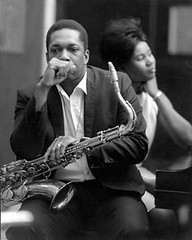
John Coltrane and Alice Coltrane during the 1960s. The couple made monumental contributions in the field of music and social consciousness.
Originally uploaded by Pan-African News Wire File Photos
Working in the bebop and hard bop idioms early in his career, Coltrane helped pioneer the use of modes in jazz and later was at the forefront of free jazz.
He was prolific, making about fifty recordings as a leader during his recording career, and appeared as a sideman on many other albums, notably with trumpeter Miles Davis and pianist Thelonious Monk. As his career progressed, Coltrane's music took on an increasingly spiritual dimension. His second wife was pianist Alice Coltrane, and their son Ravi Coltrane is also a saxophonist.
He influenced innumerable musicians, and remains one of the most significant tenor saxophonists in jazz history.
As a teen he left his home in High Point, NC, and moved to Philadelphia. He studied music; he enlisted in the Navy.
In 1945 he saw Charlie Parker perform for the first time. In a DownBeat article in 1960 he recalled: "the first time I heard Bird play, it hit me right between the eyes.
Miles Davis found him and invited him to join his quintet. In 1956 they did the albums issued as Cookin', Relaxin', Workin', and Steamin', some of the most treasured titles in Davis's early discography. The group disbanded in mid April due partly to Coltrane's problematic heroin addiction.[1]
During the later part of 1957 Coltrane worked with Thelonious Monk at New York’s Five Spot, a legendary jazz club, and played in Monk's quartet. The resulting album, Thelonious Monk Quartet with John Coltrane at Carnegie Hall, has been widely acclaimed.
Coltrane rejoined Davis in January 1958. In October 1958, jazz critic Ira Gitler coined the term "sheets of sound" to describe the style Coltrane developed during his stint with Monk and was perfecting in Miles' group, now a sextet. His playing was compressed, with rapid runs cascading in hundreds of notes per minute. During this time he performed on Kind of Blue, and the live recordings Miles & Monk at Newport and Jazz at the Plaza.[1]
Coltrane recorded his first album comprising his own compositions exclusively, Giant Steps. The title track is generally considered to have the most complex and difficult chord progression of any widely-played jazz composition.
With Atlantic Records, for whom he had recorded Giant Steps, his first record with a new group was also his debut playing the soprano saxophone; the album was the hugely successful My Favorite Things.
In the early 1960's he recorded for Impulse Records and expanded his experimental style. Critics were fiercely divided in their estimation of Coltrane. Audiences, too, were perplexed; in France he was famously booed during his final tour with Davis. In 1961, Down Beat magazine indicted Coltrane, along with Eric Dolphy, as players of "Anti-Jazz" in an article that bewildered and upset the musicians.
He responded by making albums which were more conservative and accessible. He recorded an album of ballads and participated in collaborations with Duke Ellington on the album Duke Ellington and John Coltrane and with deep-voiced ballad singer Johnny Hartman on an eponymous co-credited album.
His quartet produced their most famous record, A Love Supreme, in December 1964. A culmination of much of Coltrane's work up to this point, this four-part suite is an ode to his faith in and love for God. These spiritual concerns would characterize much of Coltrane's composing and playing from this point onwards, as can be seen from album titles such as Ascension, Om and Meditations.
Recordings in the first half of 1965 show Coltrane's playing becoming increasingly abstract, with greater incorporation of devices like multiphonics, utilization of overtones, and playing in the altissimo register, as well as a return to Coltrane's sheets of sound. In the studio, he abandoned his soprano to concentrate on the tenor saxophone. In addition, the quartet responded to the leader by playing with increasing freedom.
In 1965 Coltrane may have begun using LSD[8][9] - informing the sublime, "cosmic" transcendence of his late period, and also its incomprehensibility to many listeners. Drummer Philly Joe Jones's and pianist McCoy Tyner's departed. Coltrane and saxophonist Pharaoh Sanders were described by Nat Hentoff as "speaking in tongues". When touring, the group was known for playing very lengthy versions of their repertoire, many stretching beyond 30 minutes and sometimes even being an hour long. Concert solos for band members regularly extended beyond fifteen minutes in duration.
Coltrane died from liver cancer at Huntington Hospital on Long Island in 1967, at the age of 40. Biographer Lewis Porter has suggested, somewhat controversially, that the cause of Coltrane's illness was hepatitis, although he also attributed the disease to Coltrane's heroin use.[10]




No comments:
Post a Comment